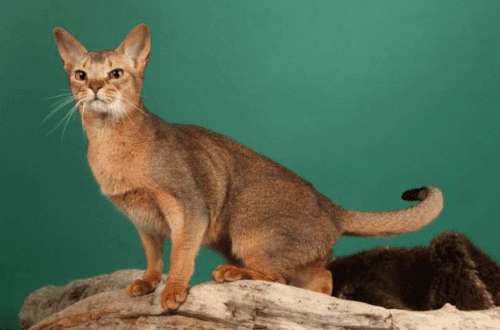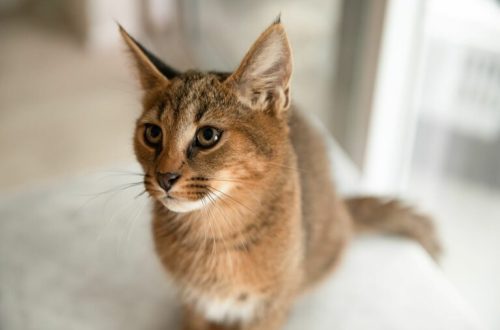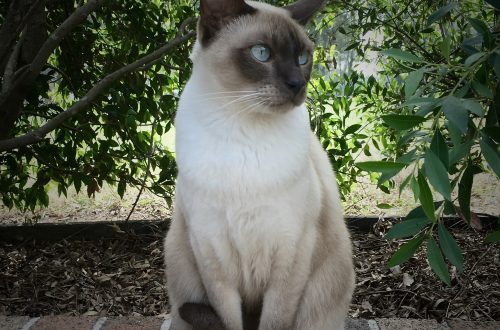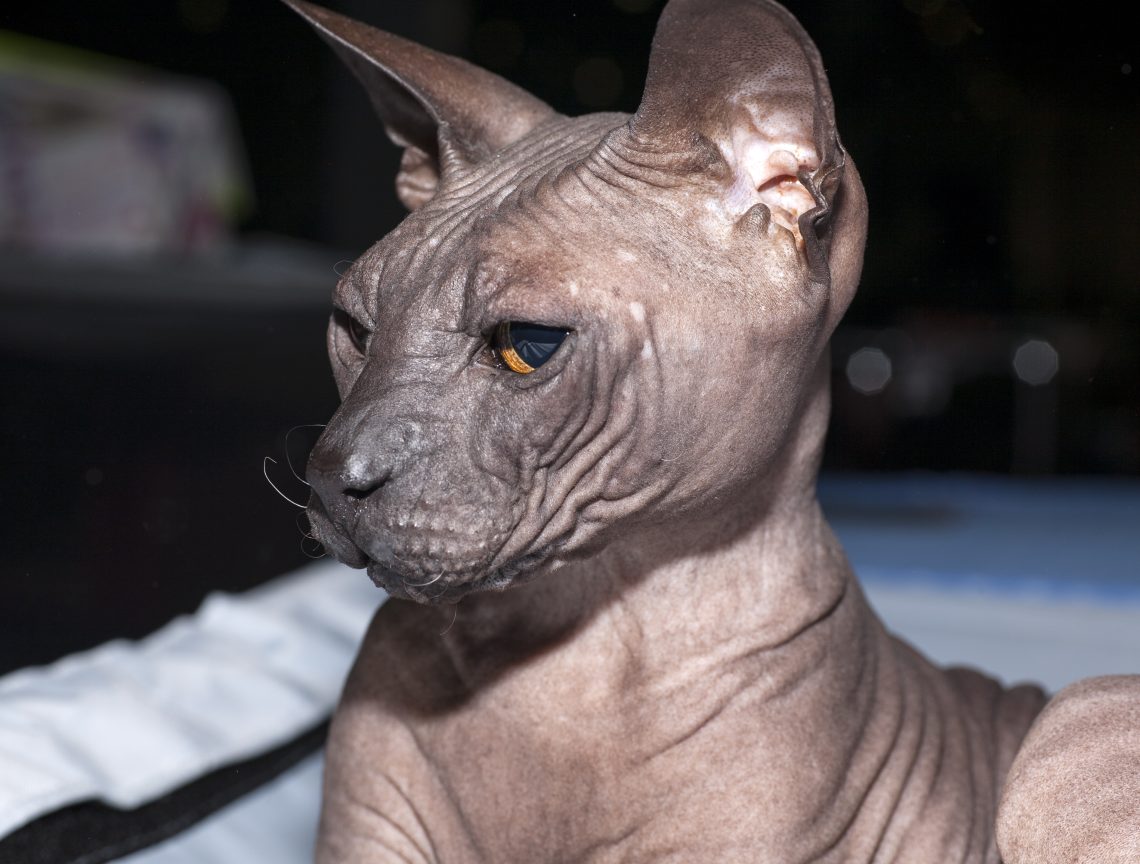
Donskoy Sphinx (Don)
Other names: donchak
The Don Sphynx is a breed of hairless cats from Rostov-on-Don. Distinguishing features: large ears, warm to the touch, wrinkled skin and strong attachment to humans.
Contents
- Characteristics of Donskoy Sphinx (Don)
- Donskoy Sphinx Basic moments
- The history of the Don Sphynx breed
- Video: Don Sphynx (Donskoy Sphinx)
- Appearance of the Don Sphynx
- The nature of the Don Sphynx
- Education and training
- Donskoy Sphinx Maintenance and care
- Health and disease of the Don Sphynx
- How to choose a kitten of Donskoy Sphinx
- Price of the Don Sphynx
Characteristics of Donskoy Sphinx (Don)
| Country of origin | Russia |
| Wool type | bald |
| Height | 23–30 cm |
| Weight | 3.5–5 kg |
| Age | 12–15 years old |
Donskoy Sphinx Basic moments
- Despite the external pretentiousness and a somewhat distant look, the Don Sphynx are considered perhaps the most good-natured and peaceful creatures on the planet.
- The body of representatives of this breed is always warm, if not hot, so if you urgently need a live heating pad, the Don Sphynx is happy to offer its services.
- Don Sphynxes eat much more than average cats. The increased appetite is explained by the intensive metabolism inherent in all hairless purrs.
- The breed is not hypoallergenic in the full sense of the word. Nevertheless, the absence of wool allows its representatives to peacefully coexist with people with allergic reactions to the Fel D1 protein.
- Most of the Don Sphynxes show an almost doggy attachment to one owner and are hard pressed by the need to move to another family.
- In terms of care and maintenance, the breed needs increased attention, including taking care of the temperature regime of the room in which the animal lives.
- Don Sphynxes are typical kinesthetics who cannot live without touching a person once again. That is why they are often called “kissing” cats.
- These hairless ears love warmth and adore sunbathing. But since an excess of ultraviolet radiation does not have the best effect on the skin of exotic pets, their exposure to the sun must be carefully dosed.
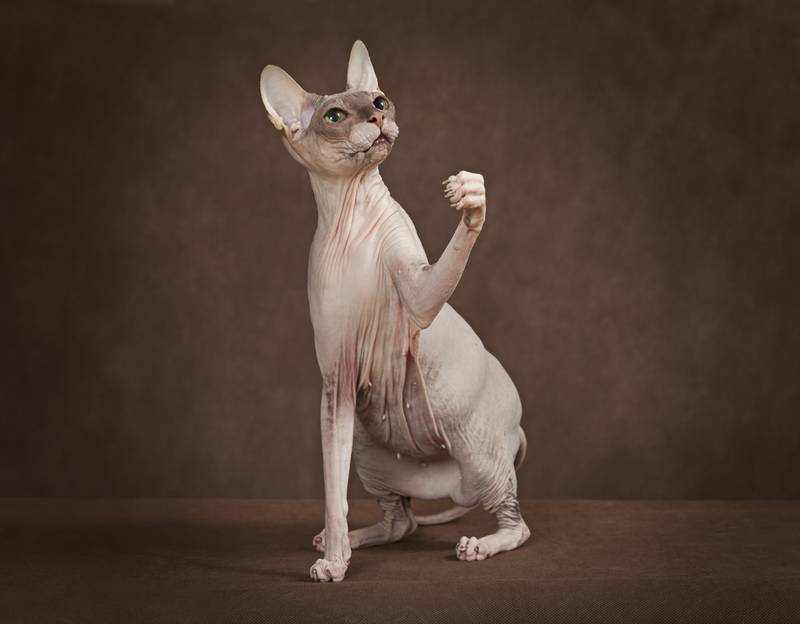
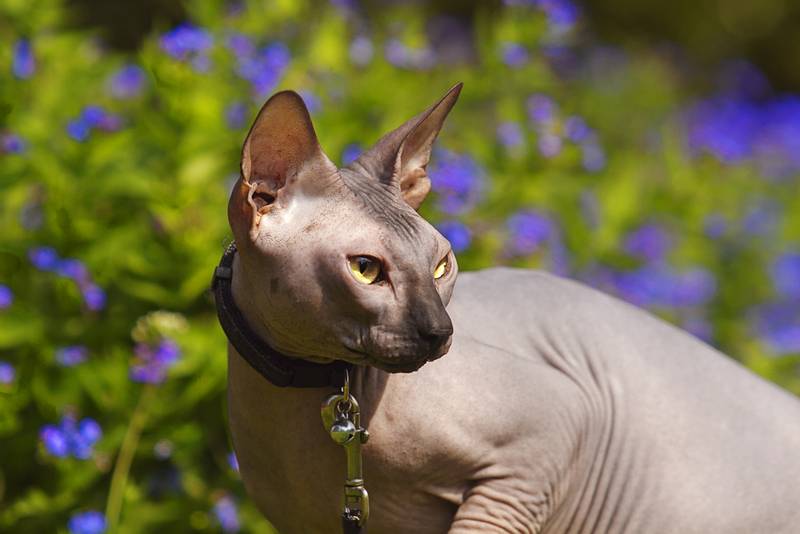
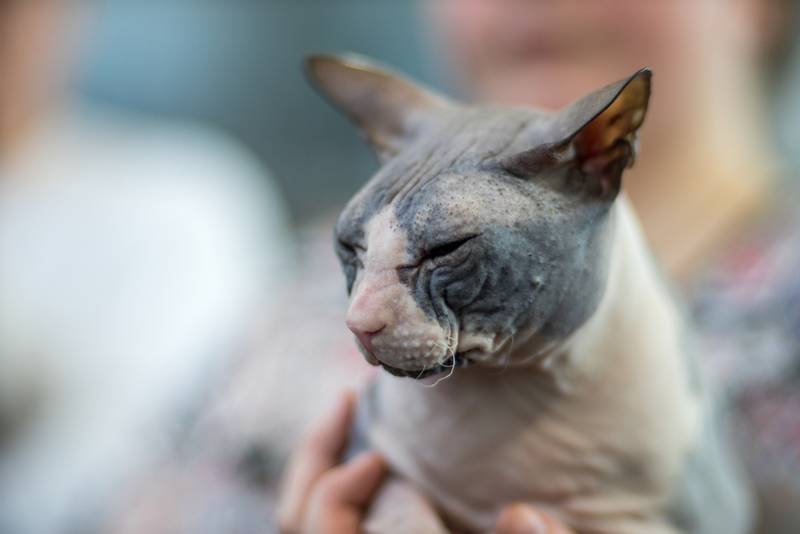
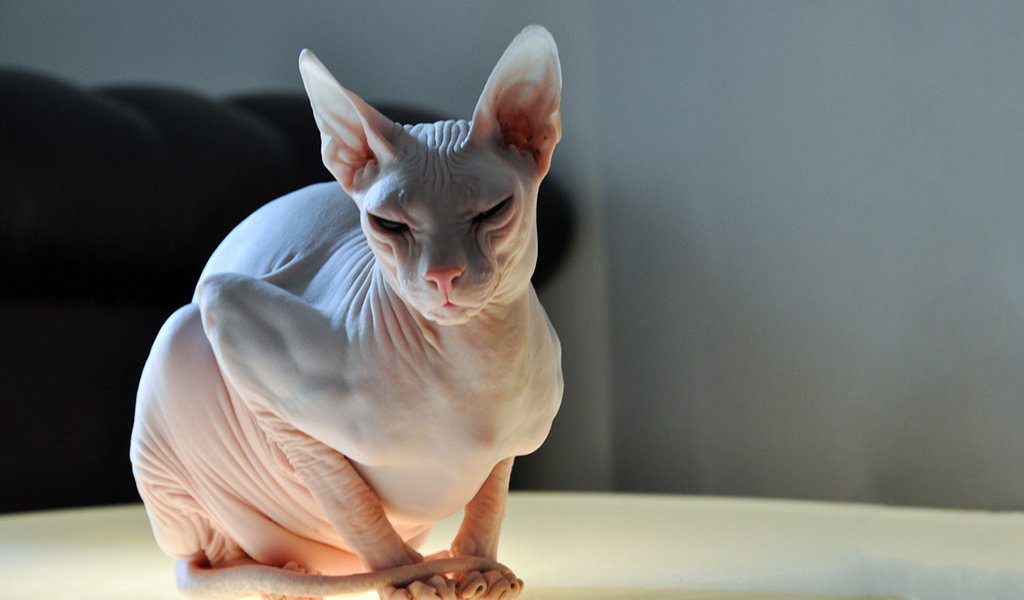
The Don Sphynx is a bright, extraordinary appearance, combined with an atypical softness of character for a cat family and a strong dependence on the owner. Most representatives of the breed are real “Cotops”, able to simultaneously act as a cozy sofa pet, and as an inquisitive companion, willingly sharing leisure time with the owner. In addition, these refined creatures make excellent physiotherapists, masterfully dealing with the consequences of neuroses and other unpleasant ailments.
The history of the Don Sphynx breed
Don Sphynxes owe their origin to His Majesty the occasion. In 1986, a resident of Rostov-on-Don, Elena Kovaleva, picked up an exhausted homeless kitten on the street, which was thoroughly mocked by local schoolchildren. The tiny creature, which turned out to be a cat, was emaciated and, moreover, had a somewhat mangy appearance, which the new owner attributed to lichen. At first, Varvara – that was the name of the mustachioed-purring creature – did not get out of the veterinarians’ offices. But since the strange baldness stubbornly resisted treatment, the animal was left alone, never interested in the amazing mutation that awarded the kitty with a hairless back. However, one specialist nevertheless showed attention to the outbred foundling, and it turned out to be Irina Nemykina. For several years, the breeder maintained a close relationship with Elena Kovaleva and her ward,
When Chita reached puberty, she was immediately mated with a European shorthair cat to get even more spectacular offspring. The fact is that Varvara’s daughter was not completely devoid of hair and had curly hair on her paws, and also, although rarely, but still a pubescent tail. Her kittens were born the same, which in no way prevented them from finding their fans and successfully traveling around exhibitions. Soon, the desire to get a completely hairless purr pushed Irina Nemykina to inbreeding, that is, at some point the breeder simply mated Chita with her son, Hannibal. The experiment went off with a bang, and in due time the cat brought several babies, one of which turned out to be completely bald and was nicknamed Basya Mif.
In 1997, the Don Sphynx was recognized by the WCF, after which the breed began to gain popularity outside of Russia. At the same time, the gene pool of Rostov cats still left much to be desired. Moreover, the unlucky feline family had to be pumped regularly, involving “third-party manufacturers”, which usually became short-haired European mousers. It was only in the early 2000s that the crossing of the Don Sphynx with other breeds began to gradually fade away, as the number of healthy breeding individuals in domestic nurseries increased markedly.
An interesting fact: as a result of mating the Don Sphynx with Siamese , Russian Blue and Turkish Angora , an independent branch of the breed appeared – peterbald .
Video: Don Sphynx (Donskoy Sphinx)
Appearance of the Don Sphynx
The appearance of the Don Sphinx evokes persistent associations with the Nile Valley, pyramids and pets of the pharaohs. And indeed, outwardly, these eared purrs dotted with elegant folds almost do not differ from the images of the first mousers found in Egyptian tombs. The cosmic image of the Rostov cats is often confusing for people who have an insufficient understanding of the breed, forcing them to classify the animals as part of the Canadian Sphynx family. In fact, the relationship between the breeds is zero point one thousandth, but there are much more differences. Take, for example, the fact that the hairless gene in Donetsk residents was and remains dominant, which allows breeders to get bald offspring even when one of the parents has a full-fledged coat. In addition, unlike the “Canadians”, Rostov sphinxes are already born completely naked, while their overseas counterparts come into this world dressed in short, but still “fur coats”.
Donskoy Sphinx Head
Cats of the Don Sphynx breed have a wedge-shaped skull with a wrinkled forehead, raised cheekbones and a convex superciliary part. The muzzle is of moderate length, slightly rounded.
Nose
The straight nose of the Don Sphynx connects to the forehead through a not very sharp, but quite pronounced transition.
Donskoy Sphinx Eyes
All representatives of the breed have wide-open, almond-shaped eyes, set somewhat obliquely.
Donskoy Sphinx Ears
Large, wide and high set, with a pronounced inclination forward. The tip of the ear cloth is rounded, while its outer edge does not extend beyond the cheeks of the animal.
Vibrissae
Vibrissae (whiskers) of the Don Sphynx are thick, curly. In some animals, the hair often breaks off at the root, which is why the cat looks completely beardless.
Donskoy Sphinx Frame
The Don Sphynx has a not too long, muscular-dense body, somewhat wide in the croup zone.
Legs
The paws of cats are of medium length, with straight forearms and noticeably extended fingers.
Donskoy Sphinx Tail
The Don Sphynx has very flexible and long tails without kinks.
Skin
A distinctive feature of the breed is the skin, which in Sphynxes is almost hot, elastic, gathering in folds on the forehead, in the armpits and groin.
Donskoy Sphinx Wool
According to the type and structure of the coat, the Don Sphynx is divided into four main types:
- naked (“rubber”) – the animal is completely devoid of hair, its skin is hot, strongly wrinkled, slightly sticky;
- flock – there is a very short and thin coat on the skin, resembling peach fluff, which disappears over time;
- velor – the pet’s hair reaches a length of 2-3 mm, but as the animal grows older, it falls out, completely opening the body;
- brush – the most hairy type of the Don Sphynx, characterized by long, but sparse, harsh and curled hair. Such cats are not allowed to exhibitions, but they are quite suitable for breeding. Usually, by the age of two years, the hair of the brushes falls out, although not always completely.
Donskoy Sphinx Color
Don Sphynx have the right to have any color, that is, they can be snow-white, black, smoky, red, blue and pinkish-red. Tabby-colored individuals are also considered full-fledged representatives of the breed, although they are combined into a separate group.
Defects and defects of the breed
The most common reasons for downgrading a show animal are too narrow, round or short head, weak constitution, too short tail and small ears. Malocclusion (undershot bite more than 2 mm) and torsion of the eyelids are considered serious defects.
The nature of the Don Sphynx
A very vulnerable soul is hiding in the body of this alien creature, craving close emotional contact with its owner. So the correct Don Sphynx is unusually soft (as far as a representative of the feline family can be), not at all jealous and absolutely not prone to aggression. Anyone can offend this good-natured eared, but no one will be able to piss him off, which makes the Donetsk residents ideal pets for families where young tomboys grow up.
Meek and loving, the Don Sphynx is always glad to “veal tenderness”, but if the owner is not yet ready for an open manifestation of feelings, it is not a sin to push him a little. There are many ways to do this, and Rostov cats have mastered almost all of them. In particular, any unoccupied knees in the house will certainly be tested by Donetsk residents for softness and elasticity, and their owner will be caressed to a semi-conscious state. At the same time, bald purrs do not suffer from excessive pestering and do not try to impose their society on someone who does not need it.
On the whole, the Don Sphynx are moderately lazy creatures, equally willingly devoting their free time to both standard cat pranks and lying on radiators. In childhood, they show strong curiosity and activity, but as they grow older, they become somewhat fed up with new impressions and look at life with a slight indifference. The peacefulness and non-conflict of the breed is already a cliché, so feel free to release parrots, hamsters, guinea pigs and other representatives of the feathery-fluffy world from the cages – the Don Sphynx does not care about them.
It is generally accepted that in the intellectual plan, the “Donetsk residents” are somewhat towering over their “woolen” relatives. Indeed, they are incredibly smart and savvy. For example, almost any adult cat knows how to deal with a door latch (long fingers, like an alien from an American blockbuster, come in handy here). In addition, they have excellent intuition: the Don Sphynx is always aware of when it is possible to play hugs with the owner, and when it is better to move away so as not to provoke the two-legged ruler to anger.
Education and training
For all its softness and pliability, the Donskoy Sphinx is no stranger to aristocratic manners. Moreover, these cats consider themselves equal to humans, so making the sphinx do something against its will is a waste of work. Yes, bald ears have a penchant for learning and are even able to put on unpretentious acrobatic sketches, but only when they themselves want to.
Not the most pleasant feature of the breed is problems with the toilet. It’s not that the Don Sphynx is unable to learn the rules for using the tray, it’s just that sometimes ancient feline instincts wake up in it, requiring immediate “marking” of the territory. By the way, most often the master’s bed suffers from the expansion of the “Donetsk resident”. There is no single way to deal with such behavior, but since you simply have to show dissatisfaction with your pet, shout at the cat or send a jet of water from a spray bottle at it. The usual oilcloth thrown over the bedspread slightly reduces interest in the master’s bed: Don Sphynxes do not favor pronounced chemical smells and the “aroma” of polyethylene.
Properly educated Don Sphynxes are not prone to aggression, but the kittens have not yet formed a behavior model, so during the game they often release their claws, spoiling the surrounding objects, and sometimes plunging them into someone’s legs. To wean your baby from such an ignoble occupation, buy more cat toys and slip them to him every time the tiny bald starts tearing the wallpaper. Often a cat spoils the interior from banal boredom and lack of attention, in this case, try to give your pet more time or get a second hairless purr so that the animals can play together. Sprinkling water on a raging hooligan is also not forbidden: it doesn’t hurt, and it’s effective.
Don Sphynxes do not have much respect for hygiene procedures, so it will take time to eradicate an innate dislike for nail trimming and bathing. To speed up the addiction process, take the space cat in your arms more often, otherwise you will have to organize a real raid on the pet later to take it to the bathroom. The usual menacing hiss also brings a good result: the animal immediately quiets down and stops pumping the rights. In fact, fear is one of the most effective methods of influencing the Don Sphynx. A strict tone, a sudden sharp sound (clapping hands) – and a bald lawless person instantly forgets about his own privilege.
It is relatively easy to instill in the Don Sphynx the skills of proper use of the tray. Moreover, with a certain perseverance, representatives of this breed can be taught to use the toilet. At first, a separate toilet seat is bought for the cat, which is placed on top of the tray, and the tray itself is placed on a pile of magazines corresponding in height to the level of the toilet bowl. After the animal gets used to doing its business, leaning on the seat, which can take from several days to a couple of weeks, the bulky structure is removed, providing the cat with a standard toilet.
Donskoy Sphinx Maintenance and care
The absence of wool does not yet make the Don Sphynx a comfortable pet. Firstly, the breed has the peculiarity of sweating – yes, these pseudo-Egyptians also smell. In addition, the skin of animals emits a brownish substance, which will have to be removed in time. It is recommended to bathe cats at least once every two weeks using a special shampoo for hairless pets. And since the breed is prone to skin rashes, it is useful to add decoctions of herbs (string, chamomile) to the bath. By the way, the temperature of the water for washing should be at the level of 39-40 ° C. In the intervals between bathing days, discharge and brownish plaque from the skin of the Don Sphynx are removed with a soft cloth soaked in warm water, or with alcohol-free wet wipes.
The tail and spine area of Donetsk residents are places where acne, pimples and boils form, so they are wiped with a ph-neutral lotion. Just do not forget to rinse the treated skin with water afterwards so that the cat is not tempted to lick off the “cosmetics”. In general, there are a lot of sebaceous glands on the tail of the Don Sphynx, which begin to work in an enhanced mode during the puberty of the animal. So even if, despite your efforts, this part of the pet’s body is covered with black dots (comedones), they will have to be squeezed out. Yes, it is unpleasant for both the owner and the cat, but it is necessary.
Due to the lack of eyelashes, the eyes of the Don Sphynx are quite vulnerable, so experts recommend rinsing them once a day, and without using cotton swabs and discs, the fibers of which can get stuck on the mucous membrane. By the way, if even with systematic care, transparent or brownish discharge accumulates in the corners, this is normal. But if the nitrous in the eyes of the “Donetsk resident” has acquired a greenish or yellowish tint, then you have a serious reason to look into the veterinary office.
The large, fan-shaped ears of the Don Sphynx quickly fill with sulfuric secretions, so they will have to be cleaned every week. If you prefer to remove the wax with a lotion, it is better, after instilling it inside, to massage the ear cloth a little – this way the dirt will quickly move away from the inner walls. Do not fall into perfectionism and do not try to clean the cat’s auricle to 200% by inserting a cotton swab deeper, otherwise you risk rewarding the animal with sudden deafness.
The claws of bald cats are long, not fully retracting into the fingertips, therefore, no matter how hard the purr tries, he will not be able to completely grind them off. Arm yourself with a nail cutter and take the initiative in your own hands, remembering the safety measures and carefully bypassing the area where the nerve endings are located. The nail bed also needs to be regularly wiped with a cloth moistened with lotion, as grease accumulates in it. A couple of times a month, the Don Sphynx teeth are brushed with fish-flavored veterinary paste or, if your pet is very patient, with soda mixed with a drop of the cheapest red wine.
The Don Sphynx develop a warm relationship with the sun: bald purrs love to arrange a solarium on the windowsill, as a result of which their skin changes color. Sometimes it comes to a real overdose of ultraviolet light, so if the pet is too sunbathing, drive him off the windowsill or take him to the shade. Otherwise, you will get an infernal creature with burned skin, which will go to tatters for a few more days. And the Don Sphynxes are often cold, so they highly respect any warm places. So if you are tired of watching how a bald adorable cuddles with a battery for days, sew warm pajamas or overalls for him – patterns can be found on the forums of breed lovers.
Donskoy Sphinx Feeding
Accelerated metabolism and increased heat transfer, characteristic of the body of the Don Sphynx, require the same increased attention to the diet of the animal. Please note that two meals a day will not be enough for a representative of this breed, so treat the cat at least three to four times a day. On a day, an adult cat should consume 150 g of lean meat (beef, veal), which will successfully replace offal a couple of times a week. Fish in the diet of the Don Sphynx plays a secondary role. Several times a month, eared fish can be treated with boiled fish fillets, but you definitely shouldn’t completely replace meat with them.
Otherwise, the Donetsk team can do everything that other kitties can. In particular, sour-milk products with a low percentage of fat, cereals in the form of cereals and vegetables in the form of salads. Raw egg yolk is very useful for hairless purrs, but because of the not very positive effect on the liver, it can be given no more than four times a month. Keeping the Don Sphynx “drying” is also quite acceptable, but if you have already spent money on such an exotic pet, forget about saving on industrial feed. The best option for “drying” for a bald cat will be holistic varieties, which do not include synthetic preservatives. If such spending doesn’t fit well with your budget, lower the bar to premium food, but never go down to economy options.
Health and disease of the Don Sphynx
The Don Sphynx is a relatively young and not the healthiest breed. Predisposition to diseases in cats is usually hereditary and due to errors in breeding. For example, various kinds of eczema and microphthalmos (improper development of the eyeball), which are often diagnosed in representatives of this family, passed to them from cats born in the early 90s, when the breed’s gene pool was unstable. Another “family” defect that can seriously ruin the life of a “Donetsk resident” is congenital torsion of the eyelids.
Breeders who sin by inbreeding often give birth to kittens with a curved caudal spine. At first glance, the disadvantage does not seem so significant, but if you mate a crooked-tailed purr with a normal cat, you can get a whole brood of real bald freaks. Nipple hyperplasia and mammary gland cyst are diseases that are typical only for cats, and the latter ailment most often makes itself felt in tortoiseshell individuals. The so-called shortening of the lower jaw (carp bite) is also a fairly common defect among the Don Sphynx. Animals with such an anomaly of development cannot fully eat and often injure their own palate with their teeth.
How to choose a kitten of Donskoy Sphinx
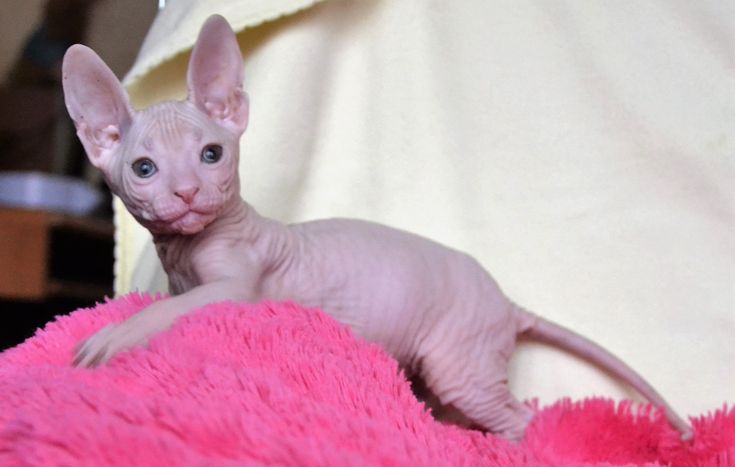
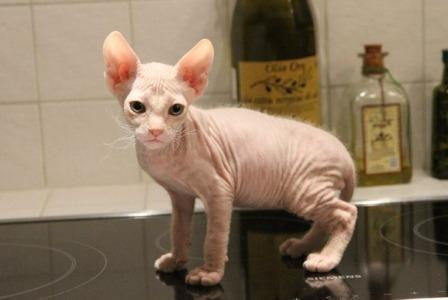

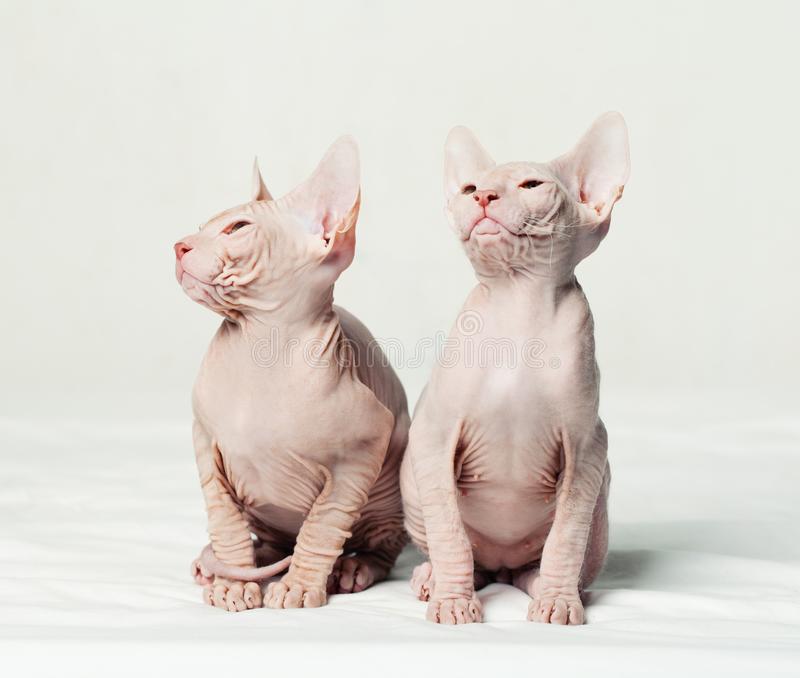
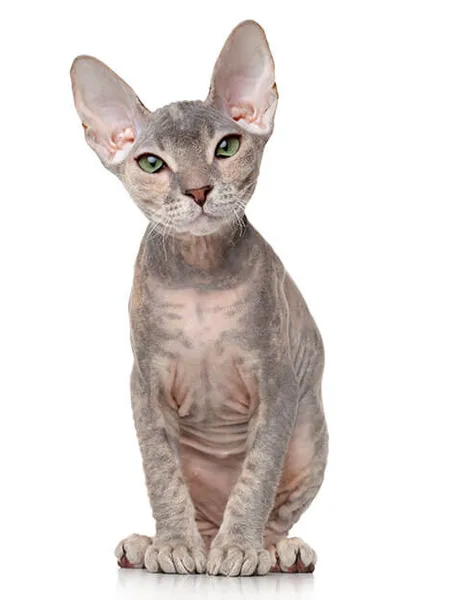
- Don Sphynx kittens are fragile, sickly creatures and often leave this mortal world in infancy. So buying a baby who is under 12 weeks old is a big and unjustified risk.
- Most parents pass on their temperament and character to offspring, so before you take a kitten, talk to his dad and mom. Suddenly they are not charming at all, but vicious misanthropes?
- Be sure to ask the owner of the cattery for the kitten’s veterinary passport. The Don Sphynx, which is taken to a new home, must receive a full package of vaccinations.
- Carefully examine every square centimeter of a potential pet’s skin. If peeling was found on it, or even worse – traces of eczema, this is a reason to leave the nursery and never return to it.
- Male and female Don Sphynx kittens differ in character. Cats are more independent and curious, and their skin and coat have a stronger smell. Kittens are more affectionate, more adventurous and are more inclined to close contact with the owner.
- The appearance of the young “Donetsk resident” is far from the last selection criterion. The right kitten, when viewed, should give the impression of a healthy and neat creature. As far as possible, avoid babies with bloated bellies, signs of diarrhea and festering eyes, as the consequences of poor care in childhood accompany the animal throughout its later life.
Price of the Don Sphynx
The average cost of the Don Sphynx without serious malformations is 250 – 600$ (depending on the class of the animal). At the same time, virtual bulletin boards are oversaturated with messages about the sale of “Donets” at absolutely fabulous prices: in the range of 70-100$. Usually, such “profitable” offers hide sick animals with fake pedigrees, whose owners are simply looking for an easy way to earn extra money.



